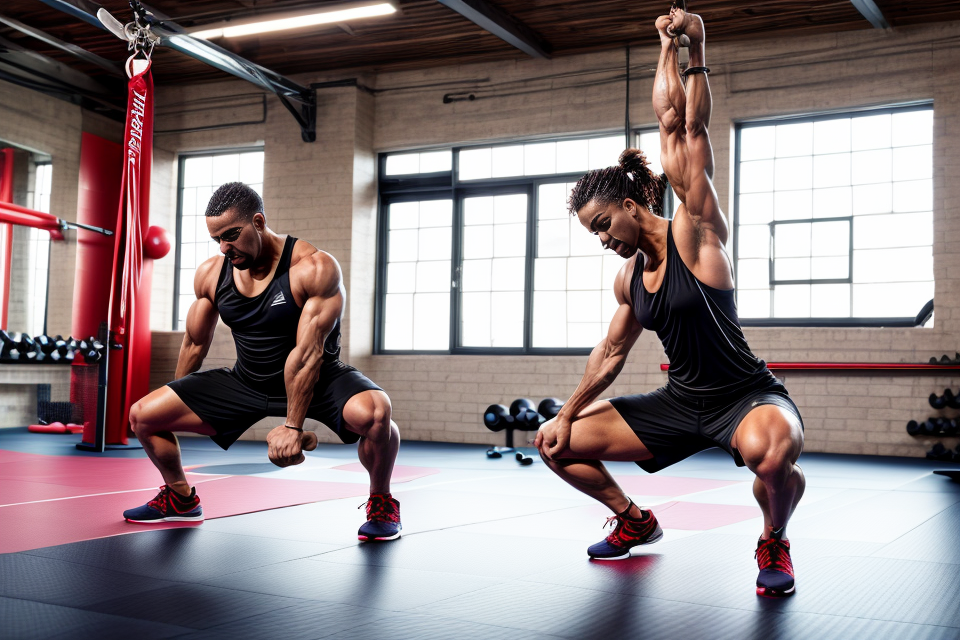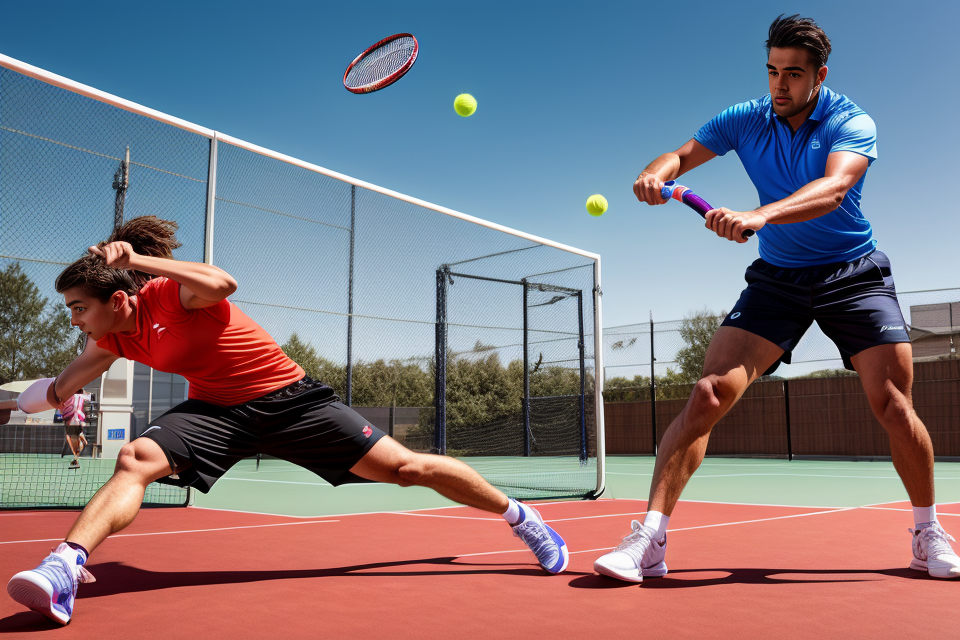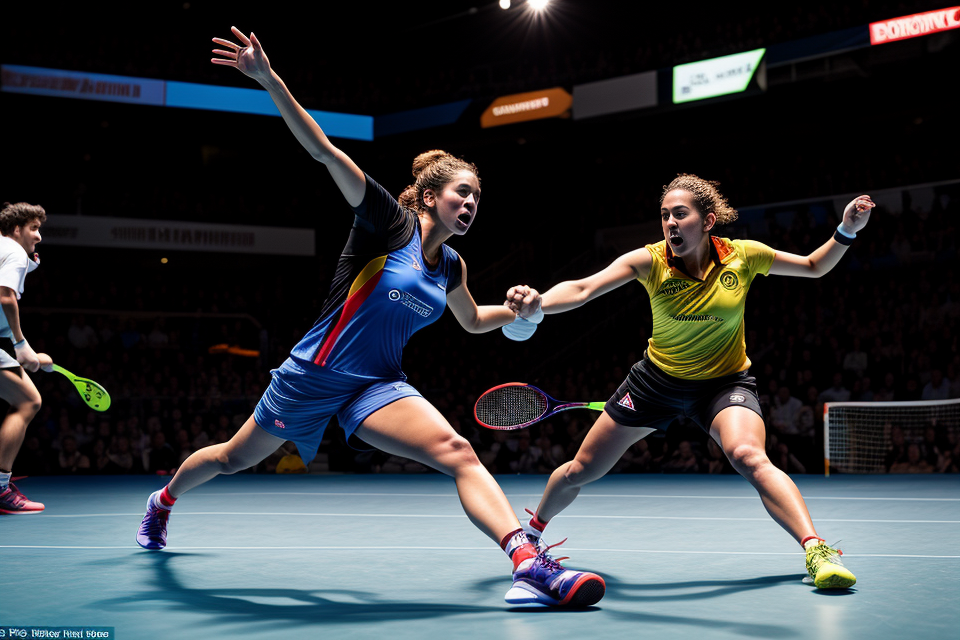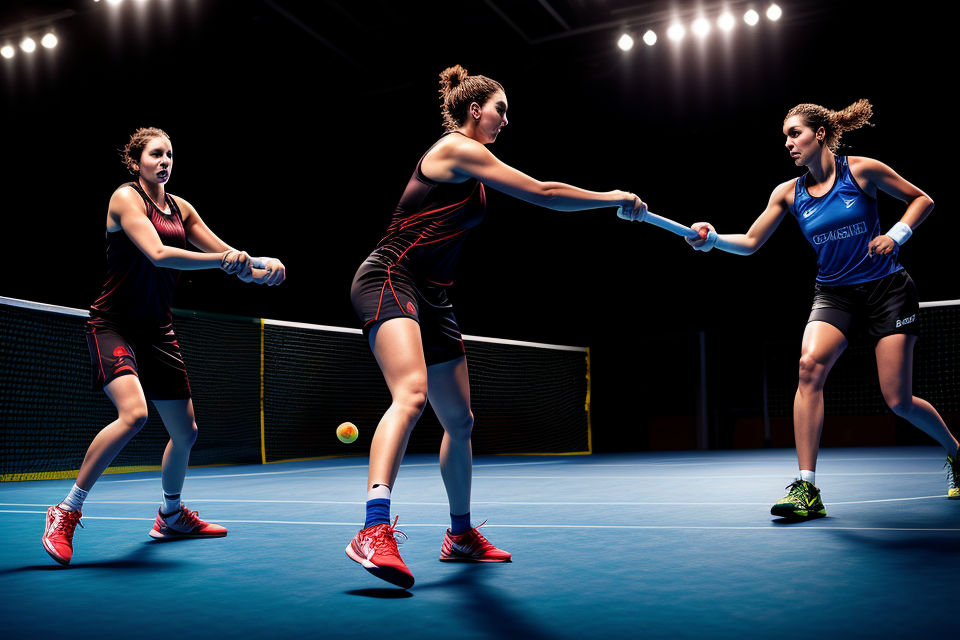Are you a squash enthusiast looking to improve your game but struggling to find the time or resources to train at a professional facility? Fear not, because with the right guidance and equipment, you can train like a pro squash player from the comfort of your own home. In this article, we will provide you with a comprehensive guide on how to train like a pro squash player from home, covering everything from setting up your training space to creating a customized workout plan. Whether you’re a beginner or an experienced player, this guide will help you take your squash game to the next level. So, let’s get started and learn how to train like a pro squash player from home!
Warm-up and Cardio Exercises
Importance of warm-up exercises
- Warm-up exercises are an essential component of any athletic training program, including for squash players.
- The primary purpose of a warm-up is to prepare the body for physical activity by increasing blood flow and elevating body temperature.
- Warm-up exercises can also help to prevent injury by increasing flexibility and improving muscle conditioning.
- In addition, a proper warm-up can improve performance by increasing heart rate and getting the muscles ready for activity.
- It is recommended to start with light cardio exercises such as jogging or cycling for 5-10 minutes, followed by dynamic stretching exercises to increase blood flow and flexibility.
- After the warm-up, players should progress to more intense cardio exercises such as interval training or high-intensity interval training (HIIT) to improve their cardiovascular endurance and overall fitness level.
- A proper warm-up is essential for preventing injury and improving performance, so it is crucial to make it a part of your regular training routine.
Cardio exercises to do at home
When training like a pro squash player from home, it’s important to incorporate cardio exercises that can help improve your endurance, speed, and agility. Here are some cardio exercises that you can do at home:
Jumping jacks
Jumping jacks are a classic cardio exercise that can be done just about anywhere, including in the comfort of your own home. To perform jumping jacks, stand with your feet shoulder-width apart and your arms at your sides. Then, jump your feet out and raise your arms above your head, landing in a squat position. From there, jump up and repeat the motion. Aim for 30-60 seconds of jumping jacks to get your heart rate up and improve your cardiovascular health.
Burpees
Burpees are another great cardio exercise that can be done at home. To perform burpees, start in a standing position with your feet shoulder-width apart. Then, drop down into a squat position and place your hands on the ground. From there, kick your feet back into a plank position and do a push-up. After completing the push-up, quickly return to the squat position and jump up from the ground. Aim for 10-20 burpees to challenge your cardiovascular system and build endurance.
Sprints
Sprints are a high-intensity cardio exercise that can be done outside or inside your home, depending on your available space. To perform sprints, find a straight stretch of space and start running as fast as you can for 20-30 seconds. Then, slow down to a jog or walk for 30-60 seconds to recover. Repeat this pattern for 10-20 minutes to improve your cardiovascular health and build speed.
Squat jumps
Squat jumps are a plyometric exercise that can help improve your power and explosiveness. To perform squat jumps, stand with your feet shoulder-width apart and lower into a squat position. From there, explosively jump up and land softly on the balls of your feet. Aim for 10-20 squat jumps to challenge your legs and improve your vertical jump.
Basic Squash Drills
Forehand drives
Forehand drives are one of the most essential shots in squash, and mastering this shot is crucial for any player. Here are some key aspects to focus on when practicing your forehand drives:
- Grip: A proper grip is essential for hitting a good forehand drive. Hold the racket with your dominant hand at the top of the handle, and your non-dominant hand at the bottom of the handle. Your dominant hand should be slightly stronger than your non-dominant hand.
- Stance: Your stance is also crucial for hitting a good forehand drive. Stand with your feet shoulder-width apart, with your dominant foot slightly forward. Keep your weight on your back foot and your knees slightly bent.
- Swing: To hit a good forehand drive, start with a slow, controlled swing. Bring the racket back to your side, then swing it forward in a smooth motion, hitting the ball with the middle of the racket. Keep your wrist snap as you hit the ball, and follow through with your swing.
It’s important to practice these shots regularly to improve your technique and develop muscle memory. Start with some basic drills, such as hitting the ball against a wall or practicing with a partner, and gradually increase the difficulty of the drills as you improve. Remember to focus on your form and technique, and don’t be afraid to slow down and practice each aspect of the shot individually if necessary. With consistent practice and dedication, you’ll be well on your way to mastering the forehand drive and becoming a pro squash player.
Backhand drives
Backhand drives are an essential aspect of squash training. They involve hitting the ball with the back of the racquet while using a backhand grip. To execute a perfect backhand drive, follow these steps:
- Grip: Hold the racquet with your dominant hand at the bottom of the handle and your non-dominant hand at the top. Keep your hands close together, with your dominant hand slightly in front of your non-dominant hand. Your palms should face toward your body.
- Stance: Stand with your feet shoulder-width apart, with your dominant foot slightly in front of your non-dominant foot. Your knees should be slightly bent, and your weight should be distributed evenly on both feet.
- Swing: Start by tossing the ball straight up about 3-4 feet high. As the ball reaches its peak, begin your swing. Keep your eyes on the ball throughout the swing. Use your dominant hand to control the racquet head, bringing it back to your side in a smooth motion. As the ball approaches, switch your grip to a backhand grip by rotating your non-dominant hand clockwise. Swing forward with your racquet, hitting the ball with the back of the racquet.
Remember to practice backhand drives regularly, focusing on accuracy, power, and control. As you progress, you can add more variations and complexities to your backhand drives, such as driving to the front or back of the court or hitting the ball with topspin or slice.
Volley
When it comes to practicing volleys in squash, there are a few key things to keep in mind. First and foremost, proper positioning is crucial. This means standing in the correct spot on the court, with your feet shoulder-width apart and your weight evenly distributed on both feet. From there, focus on your technique, making sure to keep your arms and wrists loose and your non-dominant hand in the right position to hit the ball.
Footwork is also important when it comes to volleys, as you’ll need to be able to move quickly and efficiently to get into position for the shot. Practice your footwork by moving around the court and practicing different types of volleys, such as cross-court and forehand volleys.
Additionally, it’s important to practice your volleys under pressure, so try to incorporate drills that simulate match-like scenarios. This will help you get used to hitting volleys in a high-pressure environment and improve your overall performance on the court.
Interval Training
Benefits of interval training
- Increases endurance:
- Interval training involves short bursts of intense exercise followed by periods of rest or low-intensity exercise.
- This type of training has been shown to improve cardiovascular endurance, allowing squash players to perform at a higher level for longer periods of time.
- Additionally, it can help increase the body’s ability to efficiently use oxygen, leading to improved endurance overall.
- Improves anaerobic capacity:
- Anaerobic capacity refers to the body’s ability to perform high-intensity exercise without the use of oxygen.
- Interval training is an effective way to improve anaerobic capacity, as it pushes the body to work at high intensities for short periods of time.
- This can help squash players perform at a higher level during intense rallies and sprints on the court.
- Burns more calories:
- Interval training can also be an effective way to burn calories and improve overall fitness.
- By incorporating high-intensity exercise into your training routine, you can increase your metabolism and burn more calories both during and after exercise.
- This can help squash players maintain a healthy weight and improve their overall fitness level.
Sample interval training workout
Interval training is a highly effective way to improve your fitness and conditioning for squash. It involves short bursts of intense exercise followed by periods of rest or active recovery. This type of training can help you build endurance, improve your speed and agility, and increase your overall fitness level.
Here is a sample interval training workout that you can do at home:
- Warm up for 5-10 minutes with some light cardio, such as jogging in place or jumping jacks.
- Start the interval training workout by doing 1 minute of squash-specific drills, such as hitting the ball against a wall or practicing your footwork.
- Rest for 1 minute between each interval.
- Repeat the interval training for a total of 20 minutes.
It’s important to make sure you are pushing yourself during the intense intervals and taking enough rest during the recovery periods. This will help you maximize your gains and avoid overtraining. You can also adjust the duration and intensity of the intervals to suit your fitness level and goals.
Remember to cool down and stretch after your interval training workout to help prevent injury and improve your flexibility. With consistent training, you’ll be well on your way to achieving the fitness level of a pro squash player!
Flexibility and Strength Training
Importance of flexibility and strength training
- Prevent injury: Flexibility and strength training are essential in preventing injuries in squash players. It helps to improve mobility, stability, and balance, which reduces the risk of sprains, strains, and other injuries that may occur during a game.
- Improve performance: Squash is a high-intensity sport that requires players to be in top physical condition. Flexibility and strength training can help improve overall performance by increasing power, speed, and endurance. This enables players to maintain a high level of energy throughout the game, reducing fatigue, and improving their ability to execute shots with precision.
- Increase power and endurance: Flexibility and strength training can also increase a player’s power and endurance. By improving muscle strength and flexibility, players can hit the ball with more force, move more quickly, and maintain a high level of intensity for longer periods of time. This can give them an edge over their opponents and help them win more matches.
In summary, flexibility and strength training are crucial for squash players to prevent injuries, improve performance, and increase power and endurance. It is important for players to incorporate these exercises into their training regimen to achieve optimal physical fitness and succeed on the squash court.
Stretching exercises
Proper stretching is an essential part of any physical activity, including squash. Stretching exercises help improve flexibility, prevent injuries, and enhance overall performance. Here are some stretching exercises that you can do at home to improve your flexibility and prepare for squash:
Hamstring Stretch
The hamstring muscles are located at the back of the thigh and are crucial for squash as they help in running, jumping, and changing direction. To stretch your hamstrings, follow these steps:
- Stand with your feet hip-width apart and toes pointing forward.
- Step forward with one foot and bend both knees slightly.
- Lean forward from the hips, keeping your back straight, until you feel a stretch in your hamstrings.
- Hold the stretch for 15-30 seconds and repeat on the other leg.
Calf Stretch
Tight calf muscles can cause injuries and limit your movement on the squash court. To stretch your calves, follow these steps:
- Stand with your feet shoulder-width apart and toes pointing forward.
- Raise yourself up onto your toes and then lower your heels towards the ground, keeping your knees straight.
- Hold the stretch for 15-30 seconds and repeat.
Hip Flexor Stretch
Tight hip flexors can cause pain and limit your range of motion on the squash court. To stretch your hip flexors, follow these steps:
- Bend your right knee and brace your core.
- Lean forward from your hips, keeping your back straight, until you feel a stretch in your left hip flexor.
- Hold the stretch for 15-30 seconds and repeat on the other side.
Remember to hold each stretch for 15-30 seconds and repeat on both sides. Make sure to warm up before starting these exercises and cool down after finishing them. Stretching exercises should be done regularly to improve flexibility and prevent injuries.
Strength training exercises
- Squats
- Stand with your feet shoulder-width apart and toes pointing slightly outward.
- Bend your knees and lower your body by bending at the hips and knees until your thighs are parallel to the ground.
- Push through your heels to return to the starting position.
- Lunges
- Stand with your feet together and take a large step forward with one foot.
- Bend both knees and lower your body until your back knee is almost touching the ground.
- Push through your front heel to return to the starting position and repeat with the other leg.
- Push-ups
- Start in a plank position with your hands shoulder-width apart and your body in a straight line from head to heels.
- Lower your body by bending your elbows and allowing your chest to approach the ground.
- Push back up to the starting position by straightening your arms.
Nutrition and Recovery
Importance of proper nutrition and recovery
Proper nutrition and recovery are essential components of training like a pro squash player from home. A well-rounded diet and adequate rest can significantly impact a player’s performance on the court. Here are some reasons why proper nutrition and recovery are crucial:
- Fuel the body for optimal performance: A balanced diet provides the necessary nutrients and energy for the body to perform at its best during training and matches. Carbohydrates, proteins, and healthy fats are vital for sustained energy and muscle growth. Consuming a pre-workout snack, such as a banana or energy bar, can also help to maintain energy levels during intense exercise.
- Aid in muscle recovery: Recovery is a critical aspect of training, as it allows the body to repair and rebuild muscle tissue after a workout. Proper nutrition, including adequate protein intake and hydration, can help to reduce muscle soreness and improve overall recovery time. Post-workout protein shakes or smoothies can be an effective way to aid in muscle recovery.
- Improve overall health: A healthy diet and adequate rest can have a positive impact on overall health and well-being. Eating a variety of fruits, vegetables, whole grains, and lean proteins can help to prevent nutrient deficiencies and promote a strong immune system. Additionally, getting enough sleep and taking rest days can help to reduce stress and improve mental health.
By prioritizing proper nutrition and recovery, pro squash players can optimize their training and achieve their full potential on the court.
Tips for proper nutrition and recovery
Training like a pro squash player requires not only physical exercise but also proper nutrition and recovery. Here are some tips to help you achieve a balanced diet and recover effectively from training sessions.
- Eat a balanced diet: A balanced diet should consist of a variety of foods from different food groups, including fruits, vegetables, whole grains, lean proteins, and healthy fats. These foods provide the necessary nutrients for energy, muscle repair, and overall health. It’s important to include a mix of vitamins and minerals in your diet to support physical activity and recovery.
- Stay hydrated: Proper hydration is crucial for optimal performance and recovery. Aim to drink at least 8-10 glasses of water per day, and more if you’re exercising for longer periods or in hot and humid conditions. In addition to water, you can also consume other hydrating beverages such as coconut water, sports drinks, or herbal teas.
- Get adequate sleep: Sleep is essential for recovery and overall health. Aim to get at least 7-9 hours of sleep per night to allow your body to rest and repair itself. A good sleep routine can help improve your concentration, mood, and energy levels, which are all important factors for successful squash training.
In addition to these tips, it’s also important to listen to your body and adjust your diet and recovery strategies as needed. If you’re feeling fatigued or experiencing muscle soreness, it may be necessary to adjust your training or nutrition plan to better support your needs.
Recap of key points
- Warm-up and cardio exercises: A thorough warm-up before each session is essential to prevent injury and improve performance. This can include light jogging, dynamic stretching, and jumping jacks.
- Basic squash drills: Practicing basic squash skills such as footwork, volleys, and serves will help improve your overall game.
- Interval training: Incorporating interval training into your workout routine can help increase your endurance and improve your speed on the court.
- Flexibility and strength training: Incorporating flexibility and strength training exercises into your routine can help prevent injury and improve your overall performance.
- Nutrition and recovery: Proper nutrition and recovery are crucial for optimizing performance on the court. This includes consuming a balanced diet with plenty of protein and carbohydrates, staying hydrated, and getting adequate rest and recovery time between workouts.
Continued progress and improvement
As a squash player, continued progress and improvement is essential for reaching your full potential. To achieve this, it’s important to focus on consistency, set goals, and track your progress. Additionally, seeking feedback and adjusting your training accordingly is crucial for avoiding plateaus and continuing to improve.
Consistency is key
Consistency is crucial for achieving success in any sport, and squash is no exception. To improve your game, you need to be consistent in your training and practice. This means setting aside a specific time each day or week to focus on your squash-related activities, such as drills, exercises, and matches.
Consistency also means being consistent in your nutrition and recovery habits. Eating a balanced diet and getting enough rest are essential for optimal performance on the court. By establishing a consistent routine, you’ll be better equipped to make progress and reach your goals.
Set goals and track progress
Setting goals is an important part of any training program, as it helps provide direction and motivation. When setting goals, it’s important to make them specific, measurable, attainable, relevant, and time-bound (SMART). For example, a SMART goal for a squash player might be to increase their court speed by 10% in the next three months.
Once you’ve set your goals, it’s important to track your progress towards achieving them. This can be done by keeping a training log or using a fitness tracking app. By regularly monitoring your progress, you’ll be able to see how far you’ve come and make adjustments to your training as needed.
Seek feedback and adjust training accordingly
No matter how hard you work, it’s impossible to improve without feedback. Seeking feedback from coaches, trainers, or more experienced players can help you identify areas for improvement and adjust your training accordingly.
For example, if you’re struggling with your footwork, a coach may suggest specific drills or exercises to help improve your movement on the court. By incorporating this feedback into your training, you’ll be better equipped to make progress and reach your goals.
In addition to seeking feedback from others, it’s also important to listen to your body and adjust your training accordingly. If you’re feeling fatigued or experiencing pain, it may be a sign that you need to rest or modify your training. By paying attention to your body’s needs, you’ll be able to avoid injury and continue to make progress towards your goals.
FAQs
1. What equipment do I need to train squash at home?
You don’t need much equipment to train squash at home. A squash racket, a ball, and a wall or door that you can hit the ball against are all you need. If you want to train your footwork, you can use cones or markers to set up a course on your floor.
2. What are some exercises I can do to improve my squash game?
There are many exercises you can do to improve your squash game. Some examples include hitting the ball against a wall or door, practicing your footwork by moving around the court, and doing strength and conditioning exercises to improve your overall fitness. You can also practice your strokes and shots by hitting the ball against a wall or partner.
3. How often should I train to see improvement in my squash game?
To see improvement in your squash game, it’s important to train regularly. Ideally, you should aim to train at least three times a week, with each session lasting around 30-60 minutes. If you can’t train that often, try to do at least one session per week to maintain your skills.
4. Can I still improve my squash game if I don’t have access to a squash court?
Yes, you can still improve your squash game even if you don’t have access to a squash court. By training at home and practicing your skills, you can still make progress and improve your game. It’s important to be creative and find ways to simulate match-like conditions, such as hitting the ball against a wall or partner.
5. Are there any resources available to help me train at home?
Yes, there are many resources available to help you train at home. You can find instructional videos and tutorials online that show you how to practice different skills and drills. There are also online communities and forums where you can connect with other squash players and get tips and advice on how to improve your game. Additionally, you can follow professional squash players and coaches on social media for training tips and insights.










